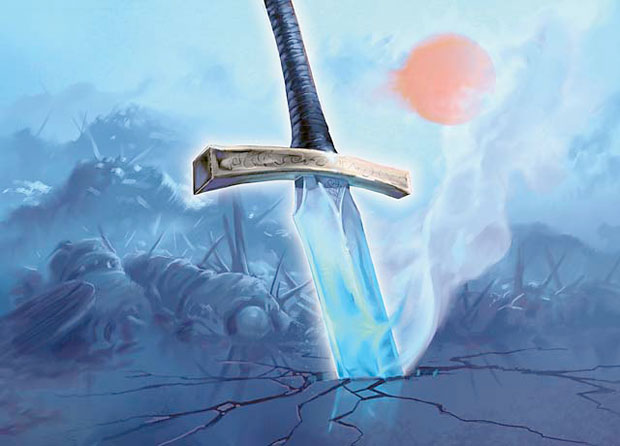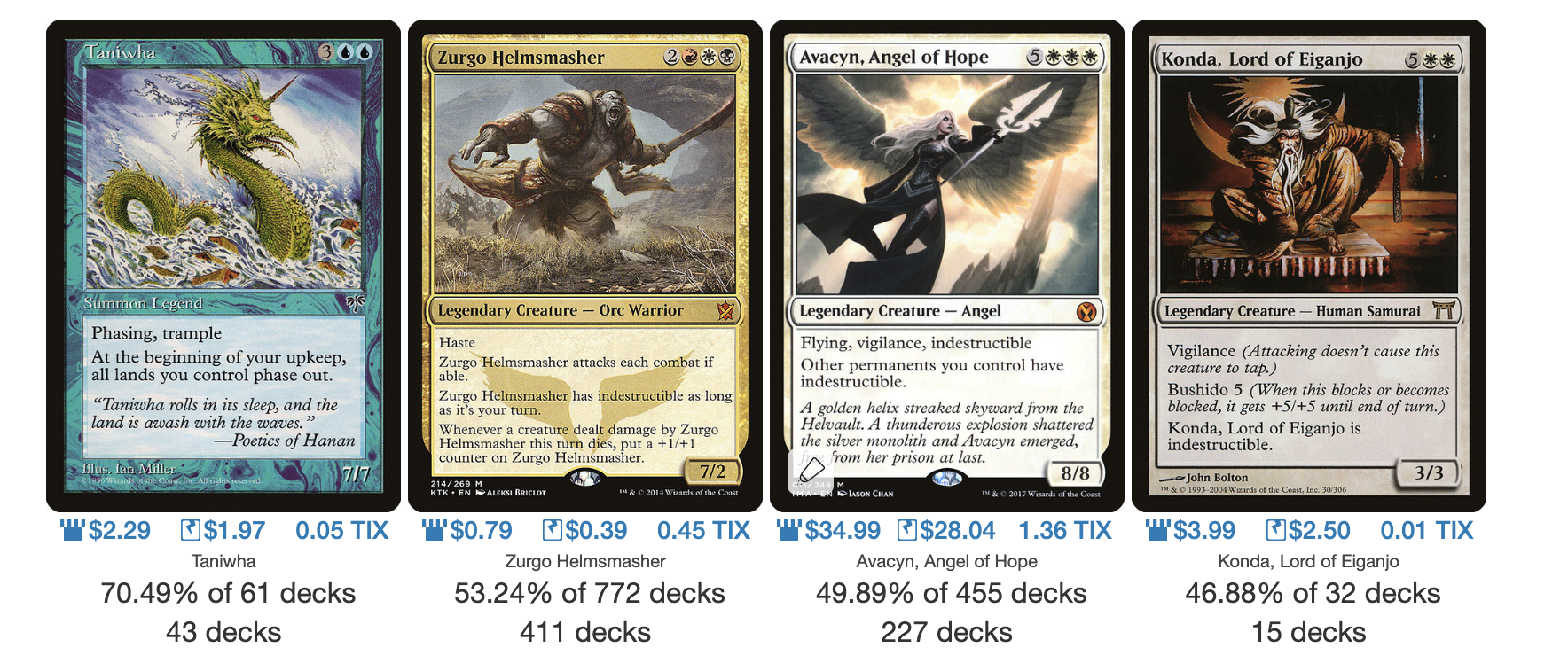(WorldslayerWorldslayer | Art by Greg Staples)
The Problems (and Opportunities) of History
During his tenure as an advisor at the Kennedy White House, historian Arthur Schlesinger was frequently interrupted by people wanting to pick his brain. They would pull him aside and ask him to divine, say, China’s trade policy in the coming decade. He soon came up with a handy deflection in his essay "The Problem of Hope":
"History cannot answer questions with confidence or certainty at short range. Alas, policy-makers are rarely interested in the long run—‘In the long run,’ Keynes used to say, ‘we are all dead’—and the questions they put to history are thus most often the questions which history is least qualified to answer."
In this case, we're going to use the practice of historiography - examining how we know what we think we know about the historical record using primary sources and reactions to same - in regards to Magic: the Gathering. We'll look at the Mirrodin block, and how it changed everything.
Documents written about history reveal as much about the time at which they were written as they do about the time they propose to examine. I believe this applies to Magic: the Gathering cards as much as it does to wills, journals, and other historical primary sources. Since 1993, Magic: The Gathering has been weaving its own history in its development into the game we know and love today. The purpose of today’s essay is to conduct a thought experiment by revisiting a period in Magic: the Gathering’s past through the lens of a particular card, and what a deck based around that card might look like in the Commander format, both when first published and in the present day.
Without further ado, let's hop in our time machine.
The year is 2003, the set is Mirrodin, which takes place on a plane of the same name. It's a world rusty and rotten with artifacts, and the card under discussion is:
By examining the changes introduced and expanded upon in the Mirrodin set, we can reconstruct what Commander decks (a much more niche format then, seeing as the first preconstructed Commander decks wouldn’t be printed until eight years later in 2011) might have looked like.
In short, we’ll be looking at an old card in a new way, as it would have been at first printing and what a Commander deck based around it might have looked like with the cards available from Mirrodin set backwards. In doing so, and by understanding the context of a particular card, we can draw upon cards that have otherwise gone overlooked in Commander and see their synergies with our subject, along the way highlighting the differences in how the cards are used together.
Mirrodin: The Set That Changed Magic
It is not an overstatement to say that the Mirrodin block changed the face of Magic: The Gathering in very real and permanent ways. The role of artifacts was greatly expanded, even into the land slot (a mistake R&D has wisely not repeated). There are two great legacies from the Mirrodin block, and I want you to take a moment and ponder what they are. One will be visible, and the other will be invisible.
Here are the top four cards on this site from Mirrodin:
All of them either are, or interact specifically with, artifacts. Most pertinent to our argument is the fact that the Equipment subtype was introduced and pushed heavily as a mechanic. Since then, there have been Equipment in every set. The reasons people generally enjoy Equipment are obvious: they're flavorful, fun, and they allow all the colors a greatly expanded toolkit for dealing with the problems of resource management and meddlesome opponents.
The second thing, the invisible change as of Mirrodin's release, was the printing of indestructible cards in Darksteel. This act would eventually lead to the phasing out of the Regenerate mechanic that existed since Magic's infancy (and at one point had actually been ruled to allow creatures to die, then be resurrected; thankfully this was changed, as it was insanely powerful).
Let me note here that there was nothing inevitable about this transition; one of the major problems with historical studies is the problem of inevitability. Our knowledge of the sequence of events taints our understanding of the end result. Viewed this way, history acquires a tinge of 'inevitability' to it for events that were far from inevitable. There was nothing inevitable about the defeat of the USSR in the Cold War, or of Nazi Germany or Imperial Japan in WWII. A complex series of factors precipitated these events. However, viewed with sufficient distance, they can seem as natural as the sun rising in the east. Don't fall into that trap!
With that caveat out of the way, let's take a look at how the meta currently uses WorldslayerWorldslayer.
How You Worldslay: 2019
In the present day, the default move for a deck that uses WorldslayerWorldslayer is to bank on a commander that is indestructible. Worldslayer comes with a hefty price tag - ten mana total to play and equip - to wipe the entire board. The natural inclination of EDH players, is to thus lean into that cost and run commanders that are indestructible or somehow protect your most valuable assets while depriving your opponents of their own.
Here are the top four commanders for Worldslayer as of this writing:
Quick breakdown: none of these creatures are green, all of them have some sort of clause that allows you to protect your resources, and all have some form of evasion. This is a strategy tested by the current meta and years of slowly integrating the 'indestructible' keyword into the game; three-fourths of the top commanders that use WorldslayerWorldslayer have indestructible, with only Taniwha as the odd eel out.
So the meta has more or less decided that Worldslayer, on average, belongs in a deck with high stickiness and an emphasis on indestructible to break Worldslayer's seemingly symmetrical damage effect.
Now let's hop back in time about 16 years.
How to Worldslay: 2003
Remember that time machine we discussed earlier, and the questions we were planning to ask because of it? Questions like, "How would WorldslayerWorldslayer look in 2003, before indestructible was a mechanic?" "What would be the most viable commander for this card back then, and what strategies would lend themselves to this new card type?"
Well, before there was indestructible, there was Regenerate. As stated above, there was nothing inevitable about the implementation of indestructibility as a replacement to regeneration; the shift has taken a decade and change to unfold. It has been a long process, and not without pitfalls, and the best way to enjoy building a deck with historical accuracy (and accuracy’s twin, satisfaction) is to imagine that what you have is what is available to you in the ancient year of 2003. Other decks you confront are time-travelers, reality-benders, bearing cards custom-made for this kitchen-table format; they'll a good test for your deck, for your way of thinking and constructing decks, to play alongside and against them. You’re testing your deck, with the best resources available to you, against a deck filled with cards from, five, ten, fifteen years in the future.
Isn’t that, at some level, kind of exciting? Limitations breed creativity, after all.
As of 2003, there were only 5 legendary creatures with regeneration clauses: RagnarRagnar, Lord of TresserhornLord of Tresserhorn, Eron the RelentlessEron the Relentless, CromatCromat, and Silvos, Rogue ElementalSilvos, Rogue Elemental (which was reprinted in Eternal Masters.
Here, green and red are best-represented colors in the lineup, a stark contrast from 2019's top commanders that we saw above. Regenerate works as a replacement effect, and is expensive; this naturally directs me towards a commander with green in its cost to allow for ramp. Let us say, for the sake of the argument, that we decided for our hypothetical build-around-WorldslayerWorldslayer deck to settle on Silvos, Rogue ElementalSilvos, Rogue Elemental as our commander. This also makes sense when we consider that in 2003, this staple of the format was printed for the first time:
This card alone would allow us a lot of leeway in picking the exact board state we want for WorldslayerWorldslayer to go off. For example, one strategy we could take as hypothetical past deckbuilders would be to pack our deck with mana-hungry regenerating beasties, which could all survive the Equipment's trigger and stick around to close out the game. In 2003, after all, that's the best insurance we have for keeping a dominant position on the board, right?
Or perhaps we could go another way: sure, regeneration is great, and we can include as much of it as we want, but what if we profited from allowing the death to happen? Enter the Symbiotic and Penumbra creatures, a pair of cycles from the Otaria and Apocalypse blocks. They're creatures that, when killed, make tokens to replace themselves! Observe:
In this way, through prodigious ramp and the use of beaters that replace themselves, we could make a deck that is formidable even without a metallic apocalypse attached to a giant creature.
A Challenge of History
I remember President Kennedy once stated...that the United States had the nuclear missile capacity to wipe out the Soviet Union two times over, while the Soviet Union had enough atomic weapons to wipe out the United States only once... When journalists asked me to comment... I said jokingly, "Yes, I know what Kennedy claims, and he's quite right. But I'm not complaining... We're satisfied to be able to finish off the United States first time round. Once is quite enough. What good does it do to annihilate a country twice? We're not a bloodthirsty people.”
(Nikita Khrushchev, in his memoirs 1974)
Let us consider the differences between a Worldslayer-focused deck in 2019 and 2003. A 2019 deck is, on average, going to bank on a heavy-hitting general, indestructible, and a reliance on a single powerhouse to win the game, decked out with Equipment and Auras. A 2003 deck's strategy, like the one we briefly explored with Silvos above, will also depend on a heavy hitter, but will instead rely on regeneration and value added effects (tokens) from the apocalypse you cause.
I would challenge all you Commander players to occasionally allow yourselves to play around with history, and see what new playstyles (or rediscovered old ones) you can unearth when you impose chronological distinctions and limits on your deckbuilding.
Please leave any comments or questions below, and stick around, because next article we're going to see what happens when the Sultai fight the Mardu, and use historical analysis of the Mongol invasion of Southeast Asia to do it!
Thanks for reading!
Charles Allison
I'm from just north of hell, I was schooled in a blossoming backwater, and currently am the worst living bureaucrat since Franz Kafka breathed his last, tremulous breath. I’ve been playing Magic: The Gathering since middle school, and Commander in particular since college, putting about a decade of experience brewing, scheming and fuming over historical travesties under my belt. I get dizzy walking in straight lines. I recently received my MFA from Arcadia University's creative writing program. My work has previously appeared in Podcastle, Stonecoast Review, Devilfish Review and Bride of Chaos.
Your opinions are welcome. We love hearing what you think about Magic! We ask that you are always respectful when commenting. Please keep in mind how your comments could be interpreted by others. Personal attacks on our writers or other commenters will not be tolerated. Your comments may be removed if your language could be interpreted as aggressive or disrespectful. You may also be banned from writing further comments.



